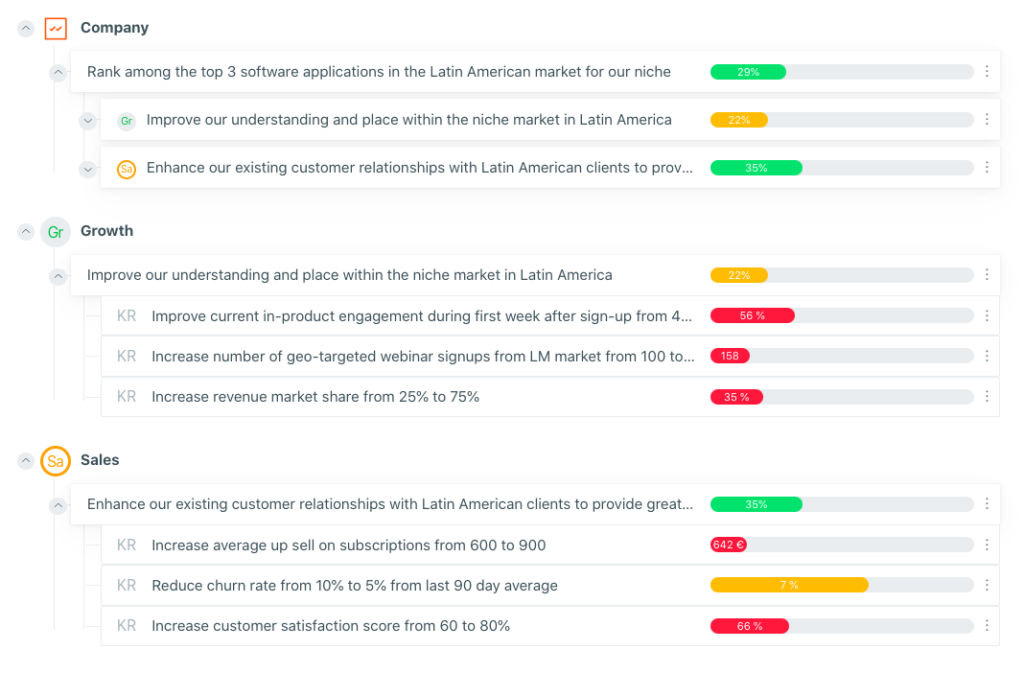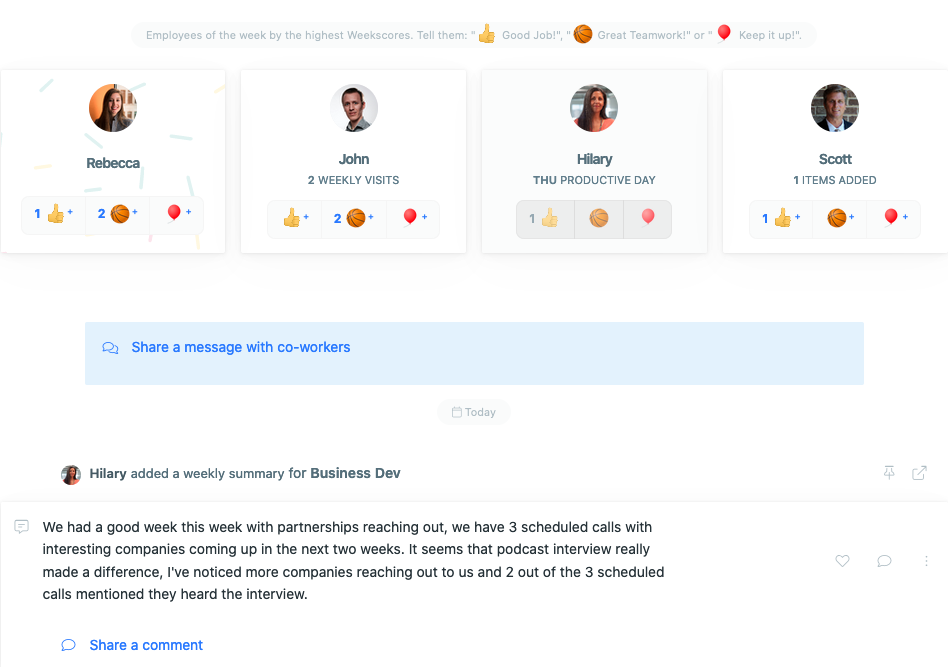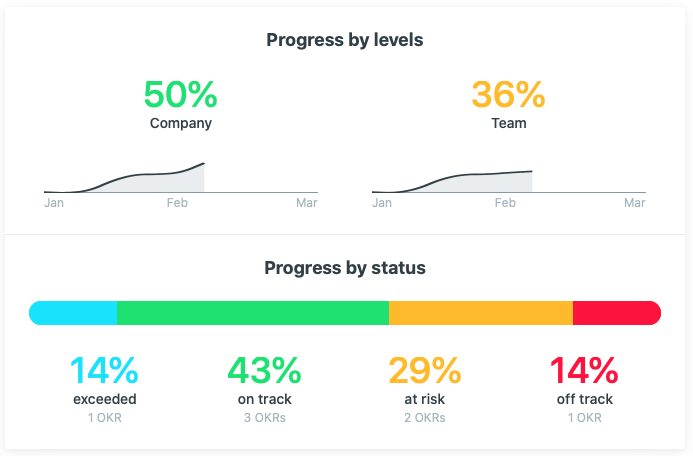Many companies and team managers have a lot of questions when they are considering implementing OKRs in their organization. Weekdone was one of the first OKR tools on the market, and have been coaching clients in OKR best practices for over 6 years. We gathered the 10 most frequently asked questions that leaders ask us about OKRs, the methodology and how OKRs would work in their teams.
Track Business Goals Easily
OKR software keeps goals front and center with tracking functionalities and visual dashboards – stay focused, achieve outcomes.
1. What are the key benefits of OKR?
There are many benefits to OKRs. One main benefit is that OKRs create intense focus and teach your teams to be result-oriented. They do this by creating clear focus for the company and teams, allowing teams to take ownership of moving the company forward, and create a unified understanding of success.
The second main benefit and one of the main reasons companies start considering using the OKR methodology is that OKRs align your whole company and move everyone in the same direction. OKRs do this through transparency and effective communication processes. You won’t have alignment if OKRs aren’t transparent and you don’t have the proper process in place, such as weekly check-ins and quarterly reviews, to move OKRs forward.
OKRs help teams drive growth, improvement and innovation. They do this by allowing teams to think about what they can contribute to achieving Company Objectives and thinking about what they can do better and how they should improve.
You can read in more detail the benefits of OKRs here.
Try OKR Software 🎯
Try OKR software with built-in examples, OKR Wizard, color-coded tracking, and visual dashboards. Stay focused – achieve goals.
2. When should my business start using OKRs?
If you run a company with 4 or more people, you may want to start using OKRs. Whether you run a startup, manage an SMB of 200 people, or enterprise corporation of 5,000 – employees, teams and managers will benefit from the implementation of the methodology.
With only 3 people in the company, it is easier to stay connected and work in a unified direction. It can be much harder when that team of 3 grows to 10, and then to 30, and then to 300. OKRs make sure teams are aligned and all work toward one or two main Company Objectives for the quarter. This is why OKRs are so popular among startups and VCs – because they scale so nicely.
OKRs are also great for larger or more established companies who are ready to improve their way of working to achieve greater success. When a company feels like teams are working in different directions, teams seem to be only doing the status quo, growth is stagnant, and the company is ready for a shift in culture in order to improve business outcomes, then it is time to implement OKRs.
It is recommended to start with OKRs as soon as possible, just because it takes time to get the right process and mindset in place. The secret behind successfully implementing OKRs is to have the right culture, motivation, knowledge and tools in place. Creating this shift with 3 people is of course easier but with the right commitment it’s also possible with 300 people. Better late than never.
3. How do we get started with OKRs now?
We have seen the most successful companies who implement OKRs follow 4 main points:
- Knowledge.
- You should have proper OKR knowledge to be able to successfully implement OKRs. Not simply reading one OKR book. Rather, ensure the whole leadership team has bought into the methodology, train your leaders on best practices, and check in regularly with progress quarter after quarter.
- Motivation
- Leadership should ignite some enthusiasm and motivation into managers and teams in order to keep them committed and driven to start a new framework. Keep open communication between teams and remove aby top down only approach to management. OKRs facilitate communication and growth.
- Culture
- Companies need to have a culture that is open and transparent, and where learning is OK. OKRs are also data-driven. If you don’t have data, then you won’t be able to properly form good OKRs and you won’t know whether you succeeded or failed. Start collecting your data today, to make better decisions in the future!
- Supporting OKR tool
- Drafting your first OKRs on a spreadsheet is good practice but once you want your teams actively collaborating and actioning around OKRs you need a tool that lets them do that. If you don’t have an OKR tool that helps foster transparency, puts into practice the processes needed for OKR success like weekly check-ins, or that is simply easy to use, then your teams will lose motivation.
4. How do I get teams on board with OKRs?
Start with being transparent. Why do you want to implement OKRs? What benefits do you feel OKRs will provide to your company to make a difference? When people see how their work matters to the overall company goals, they naturally feel more motivated, determined and engaged.
Secondly, when you are starting to implement OKRs, get an OKR coach! It is important people are properly trained and understand how OKRs work. The best way to do that, is putting them into practice with the help of someone who lives and breathes OKRs day in and day out. We offer unlimited OKR coaching sessions to all of our paid customers because we are confident that OKRs can fit any business that has the motivation and culture to do so, and our coaches can close the knowledge gap faster than reading a few books or having a 1 or 2 day workshop.
5. Should I set OKRs from top to bottom or vice versa?
Both! This is how it works. Leaders of the company come together and decide what the main focus should be for the quarter. They communicate these with Company Objectives, and context on why they decided these Objectives. The context gives teams a deeper understanding of what the goals are.
Teams then go and brainstorm what they want their Teams OKRs to be. These Teams OKRs are going to be what moves the Company Objectives forward.
It is important that leaders let their teams decide on what their OKRs should be. Teams have the expertise in their field to really know the best way to move the needle on the Company Objectives. Plus, this is what makes OKRs increase motivation and engagement! When you dictate what OKRs teams should focus on, it just tells the team that you don’t trust their judgment and expertise. Also, in many cases, cascaded OKRs tend to be just KPI targets. Leaders know what kind of performance is needed from the team (KPIs), but it doesn’t tell the teams what should be the focus to achieve these targets (OKRs). KPIs and OKRs aren’t the same thing!
That being said, teams should share their OKRs and get approval from management to make sure they properly align. It’s all about communication and working together – even though it’s important that teams should decide on their own goals, it’s also important that different Team OKRs work in parallel and not against each other.
You can read more about how to properly align OKRs in this article.
6. How to structure company OKRs?
If you are rolling out OKRs throughout your company, you would start with creating one or two Company Objectives. Company Objectives are the direction and area you want teams to focus on for the quarter. They should drive growth, change or innovation, and should be motivational.
Objectives should not have a number in it, that is what Key Results are for. In the case of the Company Objective, your Team OKRs will provide the numbers to let you know if you are achieving the Company Objective.
Company Objective Example
Improve customer retention to drive up revenue.
Add Company Objective to Weekdone
When you share the Company Objectives with your teams, it is important to include the context. When teams know all the information about why you have decided on these Company Objectives, they are more likely to come up with good OKRs that align and that drive company goals forward.
Ok, now that teams know the company goals, they can work on their Team OKRs. If you are just implementing OKRs within a team, then you would start your process here.
Teams start by creating an Objective. What is the goal they want to focus on for the quarter that will drive growth, change or innovation that will contribute to the Company Objective? Teams can have up to 1-2 Objectives, maybe 3 for a larger team (e.g team of 10 or more).
Once the Teams have an Objective, it is now time to come up with the Key Results. Key Results measure your Objective in reality. They tell you (and everyone else in your company) whether or not you achieved your Objective.
Because Key Results are measurable or quantifiable, it means they have to have a number in it. If they don’t have a number, they aren’t a Key Result! You also should be able to update your Key Result each week to make sure you are on track.
Key Results also should be outcomes, not outputs. So, for example, sending 100 emails to prospects is an output. It is something you do. It doesn’t mean it drives business value. I mean, what if those 100 prospects were bad targets and nobody books with you? An outcome would be “50 clients book demos from cold email outreach”. That is an outcome, what you hope to get from sending those 100 emails.
Each Objective should have no more than 5 Key Results, but 2-3 Key Results is the minimum recommendation.
Sales Team OKR example
O: Grow our Corporate Global Business through increasing transaction value & retention
KR: Increase closes with mid-tier package or higher from 50% to 80%
KR: Increase the company average deal size from $300 to $400 with upsells
KR: Reduce churn rate from 10% to 5% for the last 90 days.
Add Sales Team OKR to Weekdone
Remember, good OKRs focus on improvements or new activities to drive growth or change. It isn’t about business as usual. You will still have to do all the things necessary to make sure the business runs. But OKRs tell you and everyone in the company what your team will focus on to improve and grow business value.
7. Where can I find examples of OKRs?
There are two places we send people to when they are looking for OKR examples. If you are looking to see how teams create OKRs and why they chose certain OKRs, check out this article on OKR examples.
If you are just looking for examples of different team OKRs, we recommend our sister site, OKRexamples.co. You can see a list of OKRs for different departments or teams and what kind of trouble these teams can run into when creating OKRs.
It is important to note that OKRs are not something you can just copy and paste. You really need to consider not only what the Company Objective is, but what problems or areas of improvement your specific team at your specific company need in order to drive results. It’s not something you can just choose from a list!!
8. Are KPIs the same as Key Results?
This is a question we come across all the time. People sometimes think that they need to choose between OKRs or KPIs. But that is oh so wrong! Both have important business value.
KPIs are your everyday (or month or quarter) business metrics that tell you your company running on all cylinders. KPI’s have targets which tell us what kind of level of the performance we need on those metrics to make sure our company stays alive. KPI’s should also be achieved with day-to-day activities and if they are not you need to set an OKR that tells you what to focus on to fix it.
OKRs are where you want to drive growth, innovation and change. They are what sets the direction for the whole company to focus on. When you create quarterly OKRs, you are deciding how you will spend your time and resources in the next 3 months. It doesn’t mean you drop all your day to day tasks that help keep the business healthy.
Simply put, KPIs are passive, more looking to the past, answering the question “Did we hit the target or not?” OKRs are all about the future direction and improvements, actively brainstorming how to move forward. If you are still confused about the difference between OKRs and KPIs, then read this in depth article on how they differ and how both are needed in your company.
9. What tool is best for OKRs?
Well, of course, we recommend Weekdone. There are a couple of reasons why.
One is, that with spreadsheets people are 90% more likely to set OKRs and then completely forget about them until the end of the month, or worse, the end of the quarter! If you aren’t regularly planning how you will achieve your OKRs, then you won’t see success. And if you do, it was just luck and probably not a good OKR to begin with. With Weekdone, we have features such as Weekly Check-in and Newsfeed that provide the planning tools and transparency employees need to drive OKRs forward each week.
We also make updating OKRs very simple! All OKRs can be updated with just a few clicks – just type in your new measurement values, or moving the slider.
With Weekdone, you can also easily see whether your OKRs are on track for success or if they are at risk for failure at a glance, with our color coded system – see the progress by status below to understand the system.
Lastly, Weekdone was built for small and medium sized businesses in mind, which is why we offer unlimited coaching and training for paid plans at no extra cost. We understand that you don’t have the manpower to train someone for a few days (and really, a 2 day training can’t beat the experience of our OKR coaches that work with companies daily on OKR best practices).
Unlimited users try Weekdone free for 14 days
10. Who updates or owns OKRs?
OKRs should be implemented gradually. Don’t add everyone in your company to Weekdone and just ask them to quickly do something. First, introduce the OKR basics with them. We know that it’s really tempting to get everyone on board as quickly as possible, but if people are confused and setting bad OKRs, it brings no benefits.
Start by adding Company Objectives as a direction for everyone. Those can be added either by management or a chosen person to be the Tool Admin. Next step would be for the team managers to add in their OKRs to the team level and align them with Company Objectives. Now we are ready to go!
Updating is usually also in the hands of the team manager. It can also be an enthusiastic employee. More important is that there is an agreed person updating the Key Results weekly. If no one is clearly responsible for updating Key results weekly, they might not be updated at all.
We hope that this article helped answer some of your questions. However, it is very probable that you still have some questions, and even more popped up as you were reading this material. OKRs are powerful, but it takes time to create the right mindset for a cultural shift, the right knowledge to implement them successfully, and the right tool for the processes to be in place in order to succeed.
To learn more about whether Weekdone is the right software for your company, book a free demo with our OKR experts and have them show you around the product. Or start your trial today! 👇


